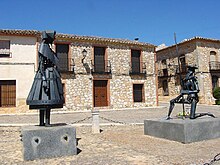Dulcinea del Toboso
Dulcinea del Toboso is a fictional literary character who becomes Don Quixote's imaginary lover in the novel Don Quixote by Miguel de Cervantes . The first name Dulcinea is derived from the Spanish "dulce" (German: sweet). Based on Cervantes' novel, Dulcinea or Dulzinea became an often ironically used synonym for girlfriend or lover in the German language .
Dulcinea in the novel Don Quixote

After Don Quixote proclaimed himself a knight, he is looking for a noble lady with whom he can fall in love, "because the traveling knight without love is a tree without leaves and fruit, a body without a soul." He chooses the farmer's daughter Aldonza Lorenzo as his lover, without her ever knowing of his love, and dresses her with the invented title Dulcinea del Toboso : “He was looking for a name for her that would not differ too much from his own and that of a princess and high mistress pointed out and aimed, and so he finally called her Dulcinea of Toboso, because she was born in Toboso ”.
While Aldonza is actually known for her handicraft in curing pork and Sancho Panza describes her with “hair on her teeth” and powerful arms and a penetrating voice, Don Quixote idealizes his noble lady with “all the impossible charms dreamed up only by bold imagination with which the poets gifted their loved ones. Her hair is gold, her forehead a paradise garden, her brow arched rainbow, her cheeks roses, her lips coral, pearls her teeth [...] "Dulcinea becomes for him" the highest embodiment of all beauty, summit and perfection of all wisdom and modesty, armory of the graceful bliss, storehouse of all modesty, model of everything that is plentiful, morally pure and refreshing on earth! "
In the course of the novel, Don Quixote repeatedly commits his deeds in the name of his mistress Dulcinea without the real Aldonza Lorenzo ever knowing about them. For Don Quixote, Dulcinea remains a Platonic love and an unattainable dream image which the real women he meets on his adventures cannot satisfy.
Real and literary role models
In his character Dulcinea , Cervantes repeatedly referred parodistically to Dante Alighieri's idealized childhood sweetheart Beatrice , who had a formative influence on Dante's work and appears in the Divine Comedy , for example . Don Quixote's designation of Dulcineas as the “mistress of his thoughts” refers to Dante's phrase “donna della mia mente”. Dulcinea's real role model is Doña Ana Zarco, who lived in the house during Cervantes' lifetime, which today can be visited in El Toboso as the "Casa de Dulcinea" and houses a museum.
Entry into parlance
Dulcinea is used today in Spanish both as a slang synonym for a beloved woman and, less often, as an expression of an ideal hope or general fantasy. The term Dulzinea found its way into the German language starting from student circles since the beginning of the 18th century and stands as a colloquial, ironic expression for girlfriend or sweetheart. The German lexicon of proverbs by Karl Friedrich Wilhelm Wander from 1867 defines:
“ His dulcinea . Dulcinea of Tolosa was the name of the mistress of the erring knight Don Quixote in the novel of the Spanish poet Cervantes, and according to this, a man's mistress is still called his Dulcinea today. "
The asteroid (571) Dulcinea and the poetry magazine Dulzinea were named after the figure of Dulcinea del Toboso .
literature
- Christoph Strosetzki: Miguel de Cervantes: Epoch - Work - Effect . Beck, Munich 1991, ISBN 3-406-35077-1 , p. 121 f .
- André Stoll: Where does Dulcinea come from and what does Cide Hamete Benengeli write? Cervantes' exploration of the Semitic intermediate worlds of Castile . In: Christoph Strosetzki (Ed.): Miguel de Cervantes' "Don Quijote" . Erich Schmidt, Berlin 2005, ISBN 3-503-07939-4 , p. 99-135 .
- Howard Mancing: Dulcinea Del Toboso: On the Occasion of Her Four-Hundredth Birthday . Hispania, vol. 88, no. 1 (March, 2005), pp. 53-63 ( JSTOR 20063075 )
Individual evidence
- ↑ a b Miguel de Cervantes Saavedra: The ingenious junker Don Quixote von der Mancha - First book, 1st chapter in the translation by Ludwig Braunfels on Project Gutenberg-DE
- ↑ Miguel de Cervantes Saavedra: The ingenious squire Don Quixote of the Mancha - First book, 13th chapter
- ↑ Miguel de Cervantes Saavedra: The ingenious Junker Don Quixote of the Mancha - First Book, 43rd Chapter
- ↑ Cf. Stoll: Where does Dulcinea come from, and what does Cide Hamete Benengeli write? , Pp. 103-104
- ↑ Claudia Diemar: On Don Quixote's birthday in La Mancha . In: Berliner Zeitung of June 18, 2005
- ^ Diccionario de la lengua Española of the Real Academia Española
- ^ Rudolf Köster: Proper names in the German vocabulary . Walter de Gruyter, Berlin 2003, ISBN 3-11-017701-3 , p. 41
- ↑ German Sprichwort Lexikon, 1867 at Zeno.org

